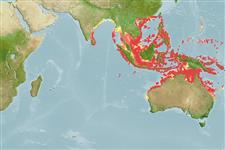Actinopterygii (ray-finned fishes) >
Perciformes (Perch-likes) >
Lutjanidae (Snappers) > Lutjaninae
Etymology: Lutjanus: Malay, ikan lutjan, name of a fish.
Environment / Climate / Range
Ecology
Marine; reef-associated; depth range 1 - 80 m (Ref. 9710). Tropical, preferred ?; 23°N - 27°S, 79°E - 159°E (Ref. 55)
Indo-West Pacific: India to northern Australia. Sometimes referred to as Lutjanus chrysotaenia by past authors.
Length at first maturity / Size / Weight / Age
Maturity: Lm 18.6 range ? - ? cm
Max length : 40.0 cm TL male/unsexed; (Ref. 55); common length : 30.0 cm TL male/unsexed; (Ref. 55); max. reported age: 20 years (Ref. 37970)
Dorsal
spines
(total): 10;
Dorsal
soft rays
(total): 14-16;
Anal
spines: 3;
Anal
soft rays: 9. Snout somewhat pointed, dorsal profile of head steeply sloped. Preorbital bone about equal to eye diameter, or slightly wider. Preopercular notch and knob poorly developed. Scale rows on back rising obliquely above lateral line. Generally blue-gray on upper side, grading to white or yellow white ventrally with a series of eight or nine or orange or yellow stripes on the sides. The fins are yellowish; the pectoral fins have a distinct black spot at base of uppermost rays and axil.
May be found in turbid coastal waters (Ref. 90102). Adults inhabit coral reefs in both sheltered lagoons and on outer reef slopes. Often encountered in schools of up to 20 to 30 individuals. (Ref. 55)
Multiple spawner.
Allen, G.R., 1985. FAO Species Catalogue. Vol. 6. Snappers of the world. An annotated and illustrated catalogue of lutjanid species known to date. FAO Fish. Synop. 125(6):208 p. Rome: FAO. (Ref. 55)
IUCN Red List Status (Ref. 115185)
CITES (Ref. 94142)
Not Evaluated
Threat to humans
Harmless
Human uses
Fisheries: minor commercial; gamefish: yes
More information
ReferencesAquacultureAquaculture profileStrainsGeneticsAllele frequenciesHeritabilityDiseasesProcessingMass conversion
Tools
Special reports
Download XML
Internet sources
Estimates of some properties based on models
Phylogenetic diversity index (Ref.
82805): PD
50 = 0.5000 [Uniqueness, from 0.5 = low to 2.0 = high].
Bayesian length-weight: a=0.01445 (0.00705 - 0.02962), b=2.98 (2.82 - 3.14), in cm Total Length, based on LWR estimates for this Genus-body shape (Ref.
93245).
Trophic Level (Ref.
69278): 3.9 ±0.5 se; Based on diet studies.
Resilience (Ref.
69278): Medium, minimum population doubling time 1.4 - 4.4 years (K=0.37-0.45; tmax=20; Fec > 10,000).
Prior r = 0.57, 2 SD range = 0.33 - 0.97, log(r) = -0.56, SD log(r) = 0.27, Based on: 3 K, 2 tgen, 1 tmax, 2 Fec records
Vulnerability (Ref.
59153): Low to moderate vulnerability (32 of 100) .
